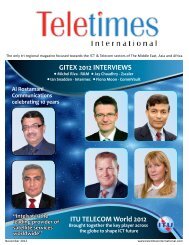Create successful ePaper yourself
Turn your PDF publications into a flip-book with our unique Google optimized e-Paper software.
to new digital technologiesand business models; theglobalization of talent will onlyboost this activity. At the sametime, however, both socialand cultural concerns remain.Fears of loss of privacy and thepotential for government abuseof the array of technologiesbeing made available will likelyincrease as the digital world isbuilt out. The growing senseof a digital divide between thetechnological “haves” and “havenots,”and the accompanyingfears of job loss, could alsostall the push, especially in lessdeveloped markets. Politicalissues, too, must be watched,given the likelihood of regionalbattles over turf and power, and“not-invented-here” reactionsto new technologies. Economicsand RisksA relatively robustinfrastructure is already inplace to support digitization.But the amount of investmentrequired to fully realize it isdaunting, both for the additionalinfrastructure needed and forthe services and applicationsto be built on top of it.Governments around the worldare contributing billions ofdollars to the effort.Yet problemsremain: Conflicting economicinterests have the potential toslow down further investmentsin infrastructure, potentiallyleaving much of it without thebandwidth and speed neededto support full digitization. Andrecent major malfunctions andincidents of theft of criticalpersonal and corporate datacontinue to raise questionsabout the risks involved inplacing too much faith in thereliability of the complex digitalenvironment. Regulation andLegal ConsiderationsThereis already considerablegovernmental and institutionalsupport for digitization,including regulations concerninghealth information and privacyissues, and laws involvingliability risks as they relate toinformation and networking, atleast in some jurisdictions. Manygovernments have also helpedpromote consistency in thecreation and use of technologicalstandards, and exerted a greatdeal of influence over the fairallocation of spectrum, for themost part. Uncertainty lingersover several of these areas,however. Spectrum is becomingscarcer, and its allocation willlikely generate fiercer fights incoming years. The debate onthe regulation of infrastructure,its construction, and fair usecontinues in many markets. Andvarious legal issues regardingliability—in the case of injuriescaused by automated systems,for instance—and ownership ofcontent rights remain largelyunresolved. TechnologyAnumber of trends in technologyare coalescing to promotethe coming transformation todigitization. We have not yetreached the limits of Moore’sLaw, and the cost of all kinds ofcomputing and communicationsequipment and devices keepsdropping. Meanwhile, theglobal implementation ofhigh-speed fixed and mobilenetworks continues apace,creating a geometric Metcalfe’sLaw effect as the value of theworld’s telecommunicationsnetworks grows in proportionto the square of the number ofconnected users of the system,dramatically increasing the valueof the Internet economy. Anddespite occasional setbacks,more and more users areadopting cloud services, a movethat is also promoting the fastercreation and adoption of highlyuser-friendly applications andprocesses. The globalization ofinnovation hotbeds—includingthe creation of Silicon Valley–like communities outside theU.S., in Russia, India, China, andSingapore, to name but a few—supports this process. Muchstill needs to be invented: Mostof the world’s infrastructureinformation is not yet digital,but scanning technologies aswell as “digital wraparounds foranalog things” will drive furthergains (see “Digitizing the High-Tech Sector,”). Knowing theaccelerators and deceleratorsaffecting the rate of digitizationin each industry and geographyis critical as CEOs and theirexecutive teams decide howto go about taking advantageof these trends. And while wewould not recommend standingin the way of digitization, itgoes without saying that anyoneseeking to retard the rate ofchange will also want to beginby making sure they understandthe factors driving digitization.CONCLUSIONWe expect, indeed hope,that a key conclusion of ourstudy—that the digitizationphenomenon has reached apoint of inflection and the rateof change is accelerating—willnot come as a surprise to theCEOs and executive teams ofmost of the largest companies inthe world. They have read aboutand seen the changes alreadytaking place in any number ofindustries, most likely includingtheir own. But what this impliesfor the decisions they needto make and the capabilitygaps they need to fill, givenscarce capital and resources, isonly now becoming clear. Thework we do across the globereinforces in our minds theimportance of first assessingyour industry, geography, andcompetitive position, andthen deciding on the tradeoffsregarding where to placeemphasis and where to hold off.Understanding the acceleratorsand decelerators of change is thebest way to determine how toshape the trend to digitizationto your company’s advantage.December 2011www.teletimesinternational.com53
















